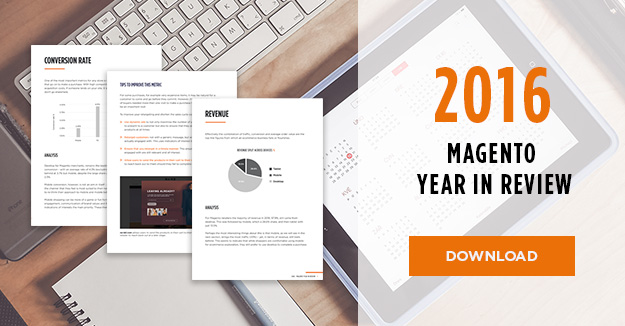Magento retailers, how are YOU doing? Three lessons from our new Magento report
No, I am not using a Joey-from-F.R.I.E.N.D.S style pick up line.
I am asking, really, how is it going? Do you know?
The problem with this question, is that in the big picture sense, you might not know.
Why?
Because ecommerce, while no game, can sometimes feel like a round of poker – everyone has numbers they have to navigate, but nobody wants to show their hand. This can make it difficult to know whether your own performance is going to see you win big or fold quicker than a poor quality deckchair.
But we’ve all watched Baz Luhrmann’s Wear Sunscreen (if you haven’t, do so. After reading this blog, of course…) and so we all know the classic line…
Sometimes you’re ahead, sometimes you’re behind. The race is long and in the end, it’s only with yourself
This is true. But (sorry Baz), in business at least, there are metrics you can measure and benchmarks you should aim for. Because to survive, if not flourish, you need to be at the industry standard, if not above.
Still, these aren’t the only things you should aim for. A quality brand with fantastic customer service, which is loved by its customers – that’s the aim. But, while I’ll be the first one to admit I’m not a “numbers person”, guess what?! Those things directly affect your metrics. Which is why metrics matter in the first place. And if you are struggling to keep up with the crowd, then it’s symptomatic of deeper problems.
Which is why, at Nosto, we created the Magento 2016 Year in Review report. Looking at the KPIs of Magento retailers in 2016 and, specifically, their device breakdown.
- Revenue Traffic
- Conversion rate
- Average basket size
- Average order value
- Visits before order
- Bounce rate
The idea is to allow you to determine whether your ecommerce business has a full house or just a lowly pair.
Now, to get a really good understanding of the results of each metric I would, of course, encourage you to read the report. Especially because that is where I put the recommendations for improving, should you fall short in any way (and really, even if you don’t, because who has ever had too much conversion?!).
But, in case you are just taking a 2 minute coffee break, let me break down three of the most interesting things I learned while writing it.
1. Desktop, in many ways, is still king
While there are more articles shouting about the importance of mobile than you can shake a stick at, desktop, in many ways, still reigns supreme. As a channel it brings the highest percentage of revenue (57.9%), is one of the biggest traffic sources (42.5%) and also has a higher average conversion rate (4.31% excluding bounce) than mobile or tablet. As if that wasn’t enough, it also saw a higher average order value than either of these channels (131 USD).
The lesson? Just because something is shiny and new and “the hottest trend” doesn’t necessarily mean you should abandon the basics. Yes, mobile is important and yes, it is going to become more and more so. But people will shop the way they want to and if you run off and put ALL your time and money into your mobile savvy shoppers then you will, ultimately, lose out.
2. But mobile is driving the most traffic
Ok, so I know what I just said – and I stand by it. But that isn’t to say you can JUST focus on the basics. As we just established, mobile is a very hot trend – and with good reason. In fact, for Magento merchants mobile is now bringing the highest percentage share of traffic (43.7%). This is a channel that has evolved at great speed from a juvenile market position. Now, what does this tell us?
Well, firstly – there is a telling discrepancy. Most people are coming to Magento stores using their phones. Yet, conversion is lowest on this channel. As I stated, in the introduction your KPIs can and should be seen as symptomatic of other issues. If conversion is low on mobile then we must not only come to the conclusion that people are still hesitant to commit and convert on this channel but also ask – why? One possibility that we must consider, is that merchants are still not doing enough to optimize the mobile experience. There is another possibility however, which leads me onto my next, and final, point…
3. We need to change the way we think of devices in the customer journey
Consumers not converting on mobile is not, inherently, a problem. As long as they go on to convert. It is only a problem if they are not converting on mobile because the experience is poor, because in that case they may give up and disappear completely.
But what if people just prefer different devices for different stages in the buying cycle? Mobiles are built with short browsing sessions in mind. They are also more likely to be used for entertainment. This means that they can be seen as more suited to the discovery stage of buying. And that is fine. In fact, if you embrace it, it could even be used to your advantage – with the use of tinder-like swiping techniques and gamification you can encourage customers to explore more of your product inventory and deepen their connection with your brand.
Three lessons from our new Magento report. But there is, of course, much more to say, as well as tips to discuss on how to improve. Don’t take it from me however, read it and find out for yourself…





